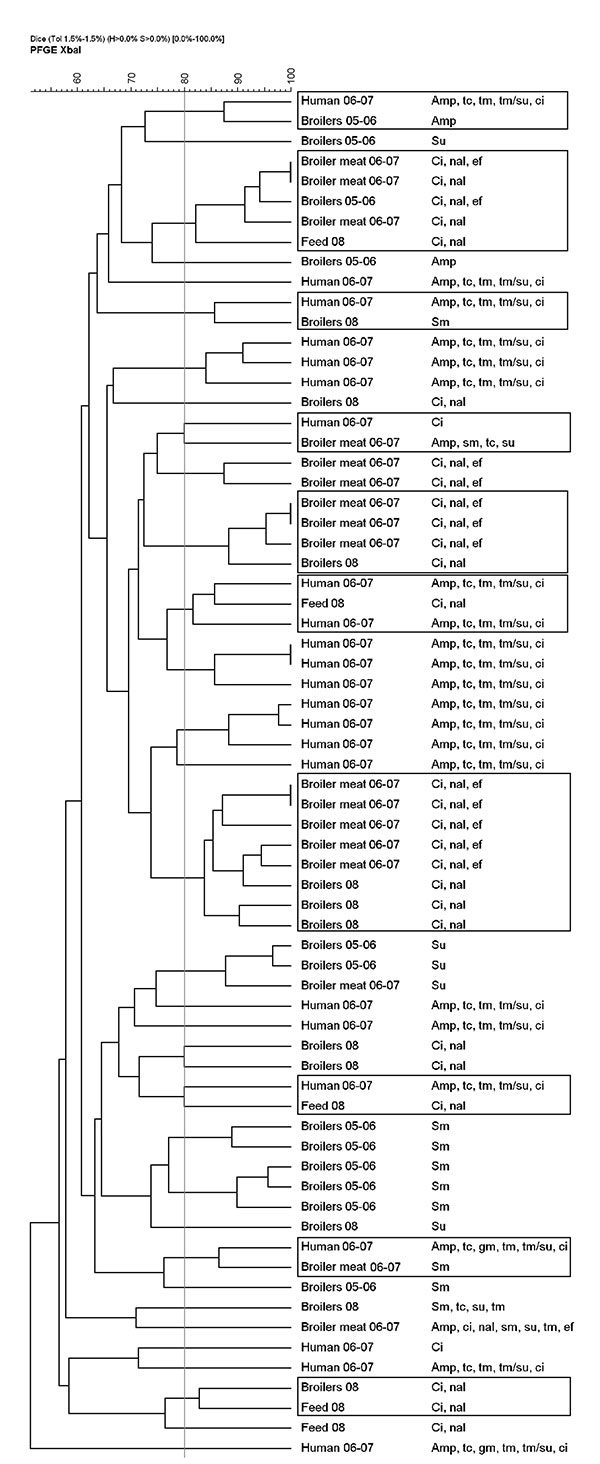Volume 16, Number 1—January 2010
Dispatch
Broiler Chickens as Source of Human Fluoroquinolone-Resistant Escherichia coli, Iceland
Figure

Figure. Dendrogram based on unweighted pair group method with arithmetic averages cluster analysis of pulsed-field gel electrophoresis (PFGE) patterns of the 20 broiler (2008), 7 feed (2008), and 34 human ciprofloxacin-resistant Escherichia coli isolates along with 29 of the most closely related broiler (2005–2006) and broiler meat (2006–2007) isolates from an earlier study (1), Iceland. Boxes indicate clusters (isolates with >80% similarity by Dice coefficient similarity analysis) of isolates of different origins not seen in the previous study. Amp, ampicillin; ci, ciprofloxacin; gm, gentamicin; nal, nalidixic acid; sm, streptomycin; su, sulfamethoxazole; tc, tetracycline; tm, trimethoprim; tm/su, trimethoprim/sulfamethoxazole.
References
- Thorsteinsdottir TR, Haraldsson G, Fridriksdottir V, Kristinsson KG, Gunnarsson E. Prevalence and genetic relatedness of antimicrobial resistant Escherichia coli isolated from animals, foods and humans in Iceland. Zoonoses Public Health. 2009 Nov 13; [Epub ahead of print].
- da Costa PM, Oliveira M, Bica A, Vaz-Pires P, Bernardo F. Antimicrobial resistance in Enterococcus spp. and Escherichia coli isolated from poultry feed and feed ingredients. Vet Microbiol. 2007;120:122–31. DOIPubMedGoogle Scholar
- Jonsdottir K, Kristinsson KG. Quinolone resistance in gram-negative rods in Iceland and association with antibiotic use [in Icelandic]. Laeknabladid. 2008;94:279–85.PubMedGoogle Scholar
- NORM/NORM-VET 2004. Usage of antimicrobial agents and occurrence of antimicrobial resistance in Norway. Tromsø/Oslo (Norway): National Veterinary Institute; 2004.
- SVARM. 2006. Swedish veterinary antimicrobial resistance monitoring. Uppsala (Sweden): National Veterinary Institute; 2007.
- Ribot EM, Fair MA, Gautom R, Cameron DN, Hunter SB, Swaminathan B, Standardization of pulsed-field gel electrophoresis protocols for the subtyping of Escherichia coli O157:H7, Salmonella, and Shigella for PulseNet. Foodborne Pathog Dis. 2006;3:59–67. DOIPubMedGoogle Scholar
- Pacheco AB, Guth BE, Soares KC, Nishimura L, de Almeida DF, Ferreira LC. Random amplification of polymorphic DNA reveals serotype-specific clonal clusters among enterotoxigenic Escherichia coli strains isolated from humans. J Clin Microbiol. 1997;35:1521–5.PubMedGoogle Scholar
- Johnson JR, Kuskowski MA, Menard M, Gajewski A, Xercavins M, Garau J. Similarity between human and chicken Escherichia coli isolates in relation to ciprofloxacin resistance status. J Infect Dis. 2006;194:71–8. DOIPubMedGoogle Scholar
- Al-Ghamdi MS, El-Morsy F, Al-Mustafa ZH, Al-Ramadhan M, Hanif M. Antibiotic resistance of Escherichia coli isolated from poultry workers, patients and chicken in the eastern province of Saudi Arabia. Trop Med Int Health. 1999;4:278–83. DOIPubMedGoogle Scholar
- Ramchandani M, Manges AR. DebRoy C, Smith SP, Johnson JR, Riley LW. Possible animal origin of human-associated, multidrug-resistant, uropathogenic Escherichia coli. Clin Infect Dis. 2005;40:251–7. DOIPubMedGoogle Scholar
Page created: March 31, 2011
Page updated: March 31, 2011
Page reviewed: March 31, 2011
The conclusions, findings, and opinions expressed by authors contributing to this journal do not necessarily reflect the official position of the U.S. Department of Health and Human Services, the Public Health Service, the Centers for Disease Control and Prevention, or the authors' affiliated institutions. Use of trade names is for identification only and does not imply endorsement by any of the groups named above.